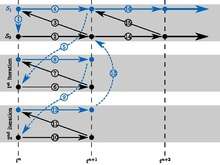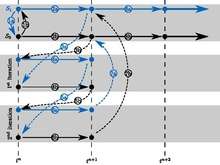Co-simulation
In co-simulation the different subsystems which form a coupled problem are modeled and simulated in a distributed manner. Hence, the modeling is done on the subsystem level without having the coupled problem in mind. Furthermore, the coupled simulation is carried out by running the subsystems in a black-box manner. During the simulation the subsystems will exchange data.
Problem Partitioning - From Monolithic to Co-Simulation
The partitioning procedure identifies the process of spatial separation of the coupled problem into multiple partitioned subsystems.
Communication Patterns
Gauss-Seidel (serial)

Gauss-Seidel sequence for two subsystems
Jacobi (parallel)

Jacobi sequence for two subsystems
Problem Decomposition
The term decomposition is used for the process of defining the input/output relations for each individual subsystem.
Software realization
For signals co-simulation can be performed with a standardized interface called Functional Mock-up Interface.
References
- Sicklinger, S.; Belsky, V.; Engelmann, B.; Elmqvist, H.; Olsson, H.; Wüchner, R.; Bletzinger, K.-U. (11 May 2014). "Interface Jacobian-based Co-Simulation". International Journal for Numerical Methods in Engineering. 98 (6): 418–444. doi:10.1002/nme.4637.
This article is issued from Wikipedia - version of the 10/29/2016. The text is available under the Creative Commons Attribution/Share Alike but additional terms may apply for the media files.